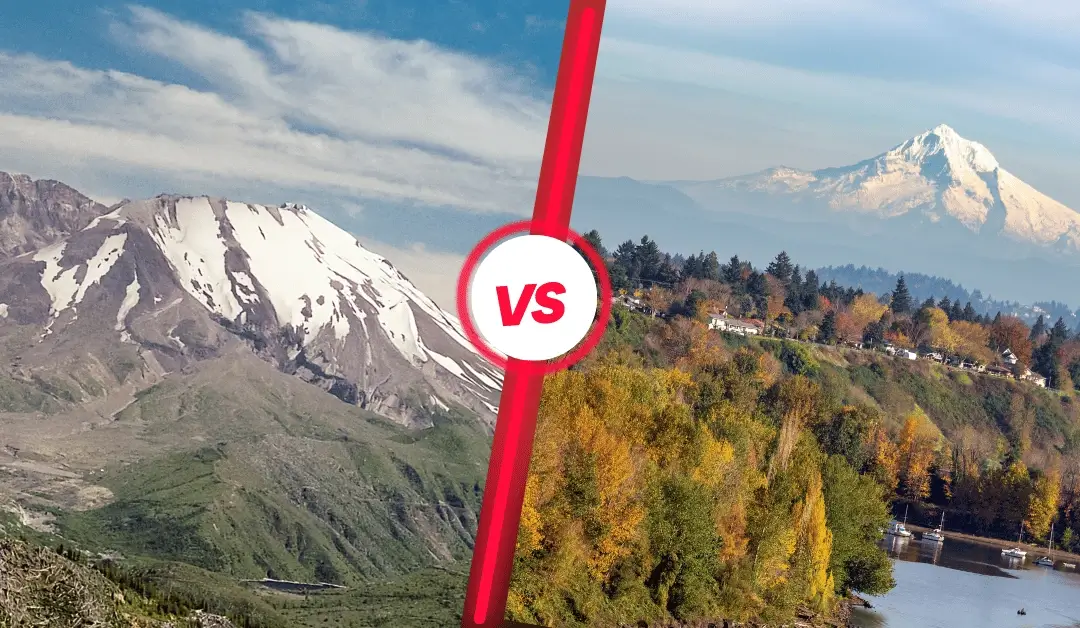Imagine yourself hiking near a volcano, where you can feel the power of nature at your fingertips and enjoy breathtaking views at every turn!
Welcome to the Pacific Northwest’s adventure playground: Mt. St. Helens and Mt. Hood. Your hiking boots will be kept busy with the routes surrounding these two legendary peaks, but which should you ascend first?
All right, get your hiking boots on! We will take a step-by-step approach to discovering what makes each mountain trail unique.

Table of Contents
Popular Hiking Trails at Mt. St. Helens
Monitor Ridge Route
If you’re up for a challenge and don’t mind a little scramble, Monitor Ridge Route is your ticket to the top of Mt. St. Helens. This is the most common method of reaching the peak, but don’t be fooled by the word “popular”—it’s not easy.

- Difficulty: Strenuous
- Length: 10 miles round trip
- Elevation Gain: 4,500 feet
You’ll begin in a forest, but the trees will soon disappear, and you’ll climb boulders in a strange, alien-looking volcanic terrain.
It’s like nature’s own obstacle course, with the prize being jaw-dropping views into the crater. Remember to carry a helmet if you intend to stare at it for an extended period—the name “active volcano” isn’t without reason!
Lava Canyon Trail
Are you looking for a way to experience a post-apocalyptic world without residing in one?
The Lava Canyon Trail is your best bet. This is the perfect mix of beauty and adventure, weaving you through lava formations and waterfalls that make you feel like you’ve landed on another planet (cue the sci-fi music).

- Difficulty: Easy to moderate, depending on how far you go
- Length: 3.2 miles round trip for the upper loop, but you can go farther if you’re feeling brave
- Elevation Gain: Around 600 feet
But be aware of the peaceful beginning; if you push yourself too far, the route will surprise you with suspension bridges and steep drops. The path almost seems to try to put you at ease before announcing, “Surprise!” Give yourself a little rush.
Boundary Trail
The Boundary Trail is ideal for people who enjoy the expansive volcanic landscape without clambering over rocks like a mountain goat. Long, picturesque walks that don’t force you to stare into the crater are ideal for taking in the rough beauty of Mount St. Helens.

- Difficulty: Moderate to complex, depending on how long you go
- Length: Varies, but a familiar route is about 8 miles
- Elevation Gain: 1,500 feet
You’ll cross streams, go through flower-filled meadows, and enjoy breathtaking countryside and blast zone views.
Advice from the pros: be ready for a long, unhurried hike and bring refreshments. Stopping often isn’t because you’re exhausted (well, maybe) but because the scenery is breathtaking.
Unique Features of Mt. St. Helens

Volcanic landscape with unique geological features:
Volcanic craters, pumice plains, and hardened lava flows provide a surreal landscape for hikers. It’s similar to going across the moon but with more hiking boots and fewer astronauts.
Challenging terrain due to loose ash and rocks:
Hiking the paths surrounding Mount St. Helens is no picnic. Carry appropriate equipment for loose ash, rocks, and boulder fields. In addition to strengthening your legs, it is a helpful reminder that maintaining your balance is essential.
Stunning views of the crater and lava flows:
What is the highlight of any hike near the peak? That breathtaking vista into the crater, with steam vents and lava domes, enhances the beauty of the landscape. As a continual reminder of the mountain’s explosive past, the expansive views of the lava flows are not to be missed.

Flora and fauna regrowth after the 1980 eruption:
Life persists despite the devastation caused! When you go hiking here, you’ll notice patches of vegetation where little trees, shrubs, and wildflowers have rebounded. Once a barren wasteland, this area is home to elk, mountain goats, and various birds.
Pros of Hiking at Mt. St. Helens

Rare volcanic landscape:
Hiking on a volcano without getting roasted has always been your dream, and now is your chance. Mount St. Helens stands out from all the other hiking destinations due to its distinctive volcanic topography.
Great for geology enthusiasts:
Mount St. Helens is like a geology version of Disneyland for those fascinated by rocks, fault lines, etc. At every turn, you can learn something new about the Earth’s dynamic terrain and the forces that shaped it into what it is today.
Various difficulty levels for different hikers:
There are pathways on Mount St. Helens for hikers of various abilities, from experienced explorers planning to reach the peak to those simply seeking a day of volcanic splendour. Various adventures await you, from strolls around the base to challenging hikes up slopes covered with ash.
Popular Hiking Trails at Mt. Hood
Timberline Trail
Every profound Oregon hiker dreams of completing the Timberline Trail. This famous 40-mile loop goes around the whole mountain and offers a little everything: high alpine meadows, towering trees, waterfalls, and breathtaking vistas from almost every direction.

- Difficulty: Strenuous
- Length: 40.7 miles
- Elevation Gain: 9,000 feet (yep, it’s a workout)
This is the trail to take for the most comprehensive Mount Hood experience. Even in the middle of summer, you can still encounter snow patches and rivers. Advice from an expert: Bring extra socks for the 40-mile trip because wet feet are no laughing matter.
Mirror Lake Trail
The Mirror Lake Trail is perfect for those who want a less strenuous hike but don’t skimp on scenery. It’s ideal for those who wish to have a little retreat into nature because it’s brief, charming, and suitable for families.

- Difficulty: Easy to moderate
- Length: 4.4 miles round trip
- Elevation Gain: 700 feet
Mirror Lake is the trail’s crown jewel; it’s a tranquil place where, on calm days, you can see Mount Hood reflected perfectly. You will need your camera because this scene is perfect for Instagram. This hike is ideal for families, and you never know; you might be lucky enough to see some frogs by the lake!
McNeil Point Trail
Those who believe in the maxim “the steeper, the better” will find the McNeil Point Trail an ideal route. Climbing Mount Hood’s steep slopes is a formidable challenge, but the payoff is a breathtaking vista at the top.

- Difficulty: Strenuous
- Length: 10.5 miles round trip
- Elevation Gain: 3,800 feet
The going is easy at first, but you shouldn’t get comfy because some steep switchbacks are coming up. It will be worthwhile when you reach McNeil Point and see the valleys and ridges that seem to go on forever below. It will be as if the world is at your feet (nearly).
Unique Features of Mt. St. Helens

Alpine meadows and dense forests:
Trails on Mount Hood lead hikers through a mystical combination of verdant, deep forests and alpine meadows carpeted with wildflowers. The picturesque scenery makes you pause and remark, “Wow, this is like something from a postcard.”
Year-round snow and glaciers near the summit:
At higher elevations, snow can still be found even in July, making the peak stand out with its white cap against the blue sky. Ice landscapes and glaciers await those brave enough to trek to the peak.
The historic Timberline Lodge and ski areas:
An iconic location for hikers, skiers, and snowboarders alike, it has stood firm since its construction in the 1930s. No skier or snowboarder should miss this lodge, which offers a cozy setting perfect for wintertime cocooning.
Extensive trail network for day hikes and backpacking:
Mount Hood’s hundreds of miles of trails make it ideal for hikes of all lengths and difficulties, from leisurely day trips to epic multi-day backpacking expeditions. Endless trails are waiting for you to discover them.
Pros of Hiking at Mt. Hood

Diverse trails:
Mount Hood’s network of paths provides everything from leisurely lakeside strolls to exhilarating mountain adventures. The transition from hiking in a mossy woodland to standing above a treeline can be accomplished in just a few hours.
Lush and green landscapes:
Mount Hood is lush and verdant in contrast to Mount St. Helens, which is more rough and rocky. If you enjoy the sensation of entering a magical forest, then you will appreciate the woodland paths
Accessible year-round:
All four seasons can be enjoyed on Mount Hood. During the summer, the mountain offers incredible hiking opportunities, while in the winter, it becomes a snowy haven for skiers, snowboarders, and snowshoers. You will never be bored here.
Hiking Trails of MT ST Helens vs MT Hood : Depth Comparison
| Features | Mt. St. Helens | Mt. Hood |
|---|---|---|
| Landscape | Volcanic, lunar-like, barren | Alpine, forested, lush |
| Difficulty | More challenging due to loose ash and rock | Variety of difficulty levels |
| Trail Types | Volcanic summits, lava flows, craters | Lakes, forests, alpine meadows, glaciers v |
| Best for | Adventurous hikers, geology enthusiasts | Scenic hikers, families, multi-day backpackers |
| Popular Trails | Monitor Ridge, Lava Canyon, Boundary Trail | Timberline Trail, Mirror Lake, McNeil Point |
| Unique Features | Volcanic landscape with unique geological features, Challenging terrain due to loose ash and rocks, Stunning views of the crater and lava flows, Flora and fauna regrowth after the 1980 eruption | Alpine meadows and dense forests, Year-round snow and glaciers near the summit, The historic Timberline Lodge and ski areas, Extensive trail network for day hikes and backpacking |
| Pros of Hiking | Rare volcanic landscape, Great for geology enthusiasts, Various difficulty levels for different hikers | Diverse trails from easy day hikes to challenging alpine routes, More lush and green landscapes, Accessible year-round for different activities (hiking, skiing) |
| Accessibility | Seasonal, mostly summer and fall | Year-round, especially for winter sports |
Which Mountain Should You Hike?

Choosing between Mt. St. Helens and Mt. Hood depends on your desired adventure.
Here’s a quick guide:
For Adventurers and Volcano Lovers: Mt. St. Helens

Who should go:
Geology aficionados and daring hikers.
This climb is exciting and challenging because of the loose ash, the rocky terrain, and the stunning vistas of the crater.
Popular routes include Monitor Ridge (to the peak) and Lava Canyon.
For Nature Lovers and Scenic Hikers: Mt. Hood

Mount Hood is best explored on foot due to its various paths, verdant woods, and alpine meadows.
It is ideal for Everyday explorers, families, and those seeking beautiful hikes.
For what it’s worth: Trails suitable for hikers of all abilities, tranquil lakes, and expansive vistas.
Top trails: Mirror Lake and Timberline Trail.
Final Verdict
In the end, it comes down to what you’re looking for:
Mt. St. Helens is perfect for a unique, rugged adventure on volcanic terrain.
Mt. Hood is ideal for hikers who crave scenic trails through lush, green forests and alpine meadows, with options ranging from easy walks to more strenuous climbs.
Hiking any mountain will be an experience you will never forget. Consequently, lace up your boots, stow your belongings in your backpack, and prepare for an adventure!







